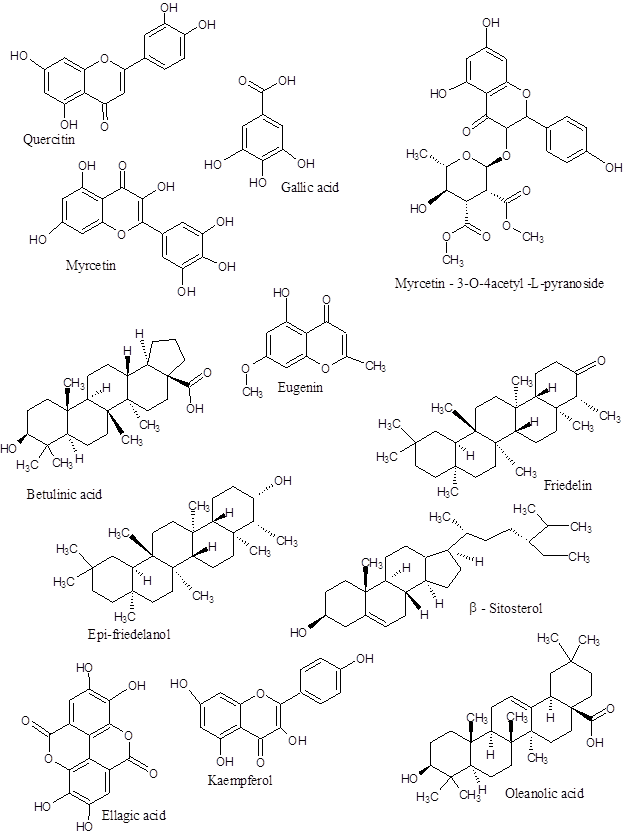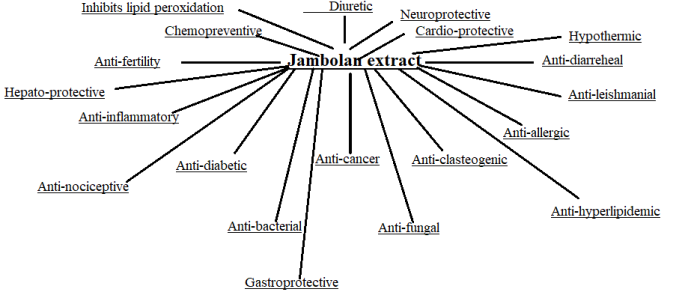Syzygium Cumini Skeels / Jambolan / Black plum / Jamun / Jambul / কালো জাম।

General features: The botanical name is Syzygium Cumini Skeel often nick named as Jambolan. In India, it is called Jamun or Jambul (Hindi) and Kalo Jam / কালো জাম (Bengali), meaning ‘black berry’ which is a misnomer to actual black berry. It is an evergreen tropical large flowering plant belonging to Myrtaceae family, originally a native of India / Andaman / Ceylon but also grows in various other regions of the subcontinent particularly in the far South East Asian nations. Syzygium Cumini also grows in Hawaii and South American tropical countries. The plant is spread by the Indian emigrants in the Caribbean islands like in Trinidad, Tobago, Guyana and even Queensland in Australia. The tree can reach more than ~ 100 ft. high. The stem is often greater than ~ 5 ft. diameter. It reaches full size in ~ 40 years. The lower bark appears discolored and coarse. The branches are gray-white. The leaves have light turpentine smell which are arranged in opposite ways. As per shape, they is elliptic, oblong and glossy green providing leathery feeling by touch; ~ 5 in long and ~ 1in wide with short pointed tips. The midrib within leaf is very prominent and yellowish, showing closely parallel lateral veins. The flowers are small white or occasionally pink, ~ 0.5 inch long growing in clusters with 4 petals fused in a cap offering nice fragrant smell. The fruits are grown in clusters of 20 – 40 in numbers, shaped ovoid and appears like berry ~ 1.0 inch long that grows in bunch with shiny dark purple appearance. In some species, the fruits are white. The berries have single seed inside. The unripen fruits are green but as they mature, it then change color, at first becoming pink then crimson red and finally attains to shiny black or deep purple. The fruiting season in India is around May or June. The fruits / berries taste delicious, a combination of sweet with a tinge of sour with touch of added astringency. When eaten, it makes the tongue purple. The woods from stems are water resistant therefore used in India for making railway sleepers or other outdoor needs. It is very hard and heavy. The tree grows all over India from the Himalayas down to Southern plain. The birds are highly fond of this berry. It is heavily loaded with anti-oxidants, vitamins and minerals thus extraordinarily beneficial for human health. Since Vedic period, the bark, leaves, trunks and fruits are therapeutically used for the sake of preventing or curing many common ailments.
History: The Hindu epic, Ramayana indicates that during fourteen years of exile in the forest, Lord Ram often survived on this fruit (Jambul). To many North Indian Hindus, it is thus considered as the ‘fruits from God’. Its fresh leaves are often used in many regions for decorations during the wedding as a sign of auspiciousness. Further, according to the Hindu mythology, Lord Krishna chose His own body color after observing the shiny bright appearance of Jambul. So, it is often seen to be planted near the Krishna temple. In many South East Asian nations, the tree is highly revered which is seen even among the Buddhists. For centuries, the tree is normally planted in the orchards for getting fruits and timber.
Use as folk medicine: Since it grows all over the tropics around world, so people are habitually using it as a folk medicine besides consuming as foods. Undoubtedly the fruits are extremely delicious and in addition it provides large quantities of minerals, fibers and anti-oxidants. All parts of the Jambolan plant, fruits, seeds, barks, leaves and stems have medicinal role. Among those applications, preventing or controlling diabetes is very common around the world. Aqueous decoction made from the fresh green matured leaves (~ 2.5 g / L) is often used to treat diabetes by the people of Southern Brazil. In India, the fruit juice or aqueous bark extract or even the mixing together is offered to cure or prevent the diabetes. In Maharashtra, the west coastal state of India, this same mixture is administered to increase appetite and preventing dysentery. It is also used to cure digestion disorders, bowel spasms, and flatulence and stomach problems. The seed extract is externally applied to cure sores and ulcers on skin. It is also used to cure dysentery, constipation and pancreas problems. In many regions of India, it is prescribed also against mental depression, nervous disorders including exhaustion. The leaf extract has strong anti-inflammatory role which can reduce the swelling of gum and removing bacteria in mouth. It is often orally administered as an antidote in the case of opium overdose or poisonous insect bites. The tasty ripen fruit juice is good for people with chronic gastric problem and women facing the problem of multiple abortions. It can cure chronic lung problems like asthma or bronchitis. According to the village apothecaries (Kaviraj) in India, Jambolan fruit and seed has the aphrodisiac effect.
Phytochemicals: The fruits, leaves, stems and barks of Jambolan plant are highly enriched with anthocyanins, Ellagic acid, Isoquercetin, Kaempherol and Myrcetin along with several of their glucosides. Additionally, the seeds contain Jambosine and glycosides like Jambolin and Antimellin. Some of them prevents breaking down of starch to sugar. The extract of seed are hugely fortified with numerous flavonoids which are widely known antioxidants enable to scavenge endogenously generated free radicals and reactive oxygen species, therefore beneficial to the health. On the other hand, the presence of Ellagic acid lowers the blood pressure significantly (~ 35 %). It is an undeniable fact that most parts of the tree is loaded with phenolics and anti-oxidants although at different levels. The fruit is fairly rich in protein, minerals and vitamins particularly Vitamin C. Approximately, 100 g of fruit flesh contains Na – 26.2 mg, K – 55.0 mg, P – 16.0 mg, Ca – 15.0 mg, fiber – 14.0 g, protein – 0.7 g, Mg – 35.0 mg, S – 13.0 mg, Fe – 1.6 mg, Cu – o.3 mg, Folic acid – 3.0 mg, riboflavin – 0.01 mg, Vitamin A – 8.1 IU, ascorbic acid – 18.0 mg.
Leaves – The fresh leaves contain Quercitin, Myrcetin, Myrcetin 3 – O – 4-acetyl – L- rhamnopyranoside, triterpenoids, tannin and enzymes like, esterase and Galloyl – carboxylase.
Stem bark – It is enriched with Betulinic acid, Friedelin, Epi-friedelanol, β – Sitosterol, Eugenin and fatty acid ester of Epi-friedelanol, β – sitosterol, Quercitin, Kaempferol, Myrcetin, Gallic acid, Ellagic acid, Bergenins, flavonoids and tannins. The presence of Gallic acid, Ellagic acid and tannins provides astringency in syrup produces from the bark.
Roots – It is rich with flavonoid glycosides and Iso-harmetin – 3 –O- rutenoside.
Flowers – It contains Kaempferol, Quercitin, Myrcetin and their glycosides and galactosides, also Myrcetin – 3 – 1-arabinoside, di-hydro-myrcetin, Eugenol-triterpenoid A, Eugenol-triterpenoid B and Acetyl – oleanolic acid.
Fruits – Fruits contain high level of raffinose, glucose, fructose, citric acid, mallic acid, gallic acid and anthocyanins. It also synthesizes Delphindin – 3 – gentibioside, malvidin – 3 – laminaribioside, petunidin – 3 – gentibiose, cyanidine diglycoside, and free petunidin and malvidin. The astringency is owing to the presence of gallic acid whereas the color is produced by the anthocyanins.
Essential oil – Each parts of the Jambolan tree produces significant amount of oil out of that ~ 80 % is essential oil by nature. The major components are α – Pinene, β – Pinene, Camphene, Myrcene, Limonene, cis – Ocemene, trans – Ocemene, γ – Terpinene, Terpinoline, Bornyl acetate, α – Copaene, β – Caryophyllene, α – Humelene, γ – Cadinene, δ – Cadinene, β – Selinene, β – Myrcene, cis – farnesol, Linoleic acid, Malvalic acid, Sterculic acid and Vernolic acid.
Below is the structure of few commonly available anthocyanin, generated in the form of reactive cation. In plant, they undergo naturally linked with the glycosides providing varieties of color in fruits, flowers and leaves. The methoxy (CH3O -) group gets linked by the enzyme catechol – O-methyl transferase.
Structure of few important phyto-chemicals in Syzygium Cumini – fruits, flowers, leaves, barks and stems

|
Phyto-chemicals |
Physiological effects of few phyto-components from Jambolan |
| Kaempferol | Flavonoid, Strong anti-oxidant, powerful anti-cancer agent by inhibiting phosphatidyl
Inositol kinase thus inhibiting neoplastic transformation. |
| Oleanolic acid | Exhibits antitumor, antiviral, anti-HIV, Anti-HCV effects, hepato-protective works by
Inducing γ – IFN. |
| β – sitosterol | Strong antitumor agent, Induces apoptosis while activating caspases in human breast
cancers and other tumor cells. |
| Eugenin | Iso-coumarin / chromone, Immune modulator, immune suppressive flavone,
antibacterial, anti-inflammatory by inhibiting COX – 1 & 2, cytotoxic to human breast cancer (MCF-7), colon cancer (HT-29) and lung cancer (A-549) cells. |
| Gallic acid | Anti-tumor agent by inducing apoptosis in numerous human cancer cells including
Prostate and cervical cancers, strong anti-oxidant, prevents tumor growth by decreasing Cyclin B1 and E also prevents amyloid protein synthesis thus protecting from dementia And any neuro-degenerative diseases. |
| Betulinic acid | Tri-terpene pentacyclic, strong anti-inflammatory, anti-HIV, anti-neoplastic induces
apoptosis, inhibits DNA topoisomerase, inhibits human metastatic melanoma by increasing p53. |
| Friedelin | Tri-terpene pentacyclic, anti-inflammatory by inhibiting TNF – α secretion. |
| Epi-friedelanol | Pentacyclic tri-terpene, anti-microbial, induces apoptosis in human cervical cancer cells,
Anti-osteoclastogenic. |
| Quercitin | Flavonoid, strong anti-oxidant, prevents lipid peroxidation thus lowering the
Cardio-vascular diseases, anticancer, helping patients suffering from the inflammation Of prostate, prevents viral infections, helping asthma patients, suffering from ulcers, Gout and chronic fatigue syndrome also possesses chemo-preventive role. |
| Ellagic acid | Di-lactone, strong anti-oxidant, powerful anti-cancer compound particularly inhibits
Carcinogen binding to DNA. |
| Myrcetin | Flavonoid, anti-oxidant, anti-carcinogenic effect, anti-viral action, anti-thrombotic,
Anti-diabetic effect, anti-atherosclerotic action, neuro-protectant, anti-inflammatory, Anti-platelet aggregation activity. |
|
Anthocyanidins |
See separately below. |
Anthocyanidins: Like any naturally synthesized colors, the color of Jambolan fruit is owing to the synthesis of anthocyanin pigments occurring in glycosylated form. In Jambolan fruits, the anthocyanidins (Delphindin, Petunidin, Malvidin, Cyanidin etc) are synthesized at very high level. Its stability depends on the medium pH. It is stable at the acidic range but undergoes color change under basic or neutral condition for ionic molecular structure, the flavylium cation. In acidic pH, they display red but with increasing pH to neutral or basic condition it gains purple or blue coloration. Due to cationic nature, anthocyanins are soluble in the water. The reaction with tannin and subsequent polymerization stabilizes the anthocyanin moiety along with protecting the color. Besides dsiplaying color, those compounds exert fabulous beneficial role on health, proven by the scientific studies following both in vivo and in vitro models. It employs large number of biological actions offering positive impacts on each human subject. They are powerful anti-oxidant as well as strong microbial by the nature. All of them help improve neurological health simultaneously protecting individuals from numerous non-communicable diseaeses. The protective role follows multiple and different pathways eg, following free radical scavenging, blocking cyclooxygenase (COX – 1 & 2) enzymes, mitogen activated protein kinase signaling pathway or preventing inflammtory cytokines generation. Additionally, they produce good impact on chronic diabetic sufferers by lowering the serum glucose level. Before the advent of insulin, it was perhaps the best treatment for diabetes.

Medicinal and pharmacological effects: Below is various pharmacological effects produced by the extracts of Jmabolan plant parts.

Interestingly the extracts of Jambolan leaf provides protection against radiation damage. Additionally, the alcoholic seed extract offers potent role against anxiety disorders, psychotic disorders, sleep disorders and eating behavior. The reaction causing lipid peroxidation and subsequent adversarial effect on cardio-vascular tissues can be prevented by the fruits pulp and seed extract.